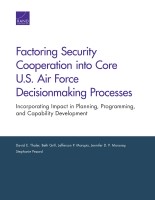| 来源类型 | Research Reports
|
| 规范类型 | 报告
|
| DOI | https://doi.org/10.7249/RR2351
|
| ISBN | 9781977400239
|
| 来源ID | RR-2351-AF
|
| Factoring Security Cooperation into Core U.S. Air Force Decisionmaking Processes: Incorporating Impact in Planning, Programming, and Capability Development |
| David E. Thaler; Beth Grill; Jefferson P. Marquis; Jennifer D. P. Moroney; Stephanie Pezard
|
| 发表日期 | 2018
|
| 出版年 | 2018
|
| 页码 | 114
|
| 语种 | 英语
|
| 结论 |
The U.S. Air Force (USAF) Can More Systematically Take Security Cooperation (SC) into Account- Although SC is stated to be a high strategic priority, it is not systematically factored into processes at lower echelons and does not appear as a systematic, explicit component of trade-offs that inform decisions.
- Important foundational analyses of USAF capabilities and gaps that help justify USAF programs often do not consider contributions of allies and partners.
- At times, USAF develops SC initiatives ad hoc outside traditional decisionmaking processes.
- SC as a mission lacks commonality with other mission and process structures in terms of metrics and differentiation of resources.
- The later in a process SC impact is initially raised, the more challenging it is to ensure that decisions about USAF programs incorporate it successfully.
- Although it is still new, the Security Cooperation Enterprise Governance Structure has had positive effects on socializing SC across USAF and synchronizing SC activities, but effects on core processes and on establishing SC priorities are not yet clear.
|
| 摘要 |
- The authors make five recommendations for near-term actions: (1) Issue USAF-wide guidance declaring security cooperation's (SC's) alignment with other missions and activities in core processes; (2) provide detailed direction in the Strategic Planning Guidance and in the Program Planning Guidance on including SC impact assessments; (3) provide detailed direction through the Capability Development Working Group to factor SC impact into concept development deliberations and products; (4) develop and standardize SC risk matrices with impact areas and questions that USAF should address as an initial step to factor SC impact into deliberations and analyses of the strategy, planning, and programming process and the concept development and acquisition process; and (5) identify personnel in Strategic Plans, Programs, Requirements and Assessments who can serve as champions of SC issues in Air Staff processes and analyses supporting the corporate structure.
- They make five recommendations for medium- to long-term actions: (1) Update USAF directives and instructions to mandate consideration of SC risks and opportunities, (2) develop mechanisms to factor partner capabilities into USAF operational and interdependency analyses, (3) identify resources for SC within USAF that are separable from other mission resources, (4) refine risk matrices and develop other assessment techniques to improve qualification and quantification of SC impact, and (5) develop dedicated SC professionals at the headquarters and major command levels to support assessment of SC impact and shepherd resulting deliberations and analyses within the core processes.
|
| 主题 | Decisionmaking
; Military Acquisition and Procurement
; Military Aircraft
; Security Cooperation
; United States Air Force
|
| URL | https://www.rand.org/pubs/research_reports/RR2351.html
|
| 来源智库 | RAND Corporation (United States)
|
| 引用统计 |
|
| 资源类型 | 智库出版物
|
| 条目标识符 | http://119.78.100.153/handle/2XGU8XDN/108752
|
推荐引用方式
GB/T 7714 |
David E. Thaler,Beth Grill,Jefferson P. Marquis,et al. Factoring Security Cooperation into Core U.S. Air Force Decisionmaking Processes: Incorporating Impact in Planning, Programming, and Capability Development. 2018.
|
|
文件名:
|
x1524141388521.jpg
|
|
格式:
|
JPEG
|

|
文件名:
|
RAND_RR2351.pdf
|
|
格式:
|
Adobe PDF
|
除非特别说明,本系统中所有内容都受版权保护,并保留所有权利。